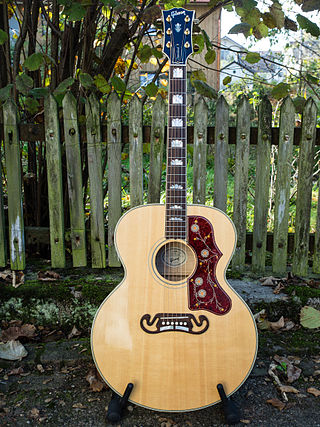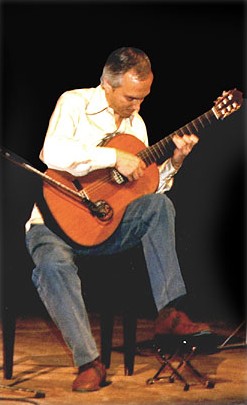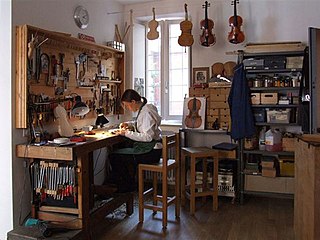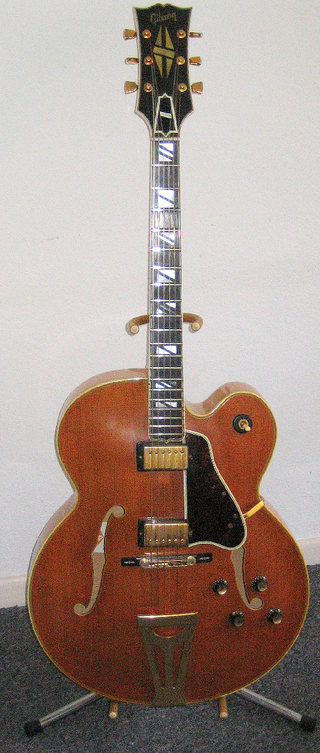Gallery
- John Williams playing his Smallman in 2005
- Smallman Rosette
- Smallman Label Until 2002
Greg Smallman (born 19 June 1947 in Cronulla, Australia) is the first internationally successful non-traditional Australian guitar-maker. He is known worldwide for his innovative guitar designs [1] [2] Although his guitars are in outward appearance similar to a traditional Spanish classical guitar, there are numerous innovative differences. [1] [2]
Among the differences from the classical Spanish guitar is the use of a high, arched and carved back, which is considerably thicker and heavier than for a conventional guitar. The back is made of Madagascar rosewood, while the top is always made of western red cedar. The light weight of the top combined with Smallman's unique system of bracing makes the guitar very responsive to input with a full rounded sound (not thin). [3] The top of Smallman guitars is braced using a "lattice" framework composed of balsa wood and carbon fibre. By contrast, traditional classical guitars use struts made of cedar or spruce arranged in a "fan" shape.
The world-renowned classical guitarists John Williams, Miloš Karadaglić, Xuefei Yang and many others use Greg Smallman guitars.
In 1999 the Greg Smallman label changed to Greg Smallman & Sons Damon & Kym. Based for many years in Glen Innes, New South Wales, in 2002 the Smallmans briefly relocated to the Mornington Peninsula outside Melbourne. The Greg Smallman and Sons workshop is now located near Esperance, Western Australia. They did not have a website till 2012. [4]
Greg Smallman is admired for the open way in which he shares his ideas. [1] [2] He does not hide them from fellow luthiers, nor has he patented them. [1] [2] A large number of luthiers worldwide have incorporated Smallman's design innovations into their own guitar designs. [1] [2]
"The Australian luthier, Greg Smallman has been responsible for a minor revolution in guitar design, bringing some subtle but important changes to the classical instrument that have had a more profound effect than those contributed by any other modern maker."
— Tony Bacon [1]
"What I find interesting and wonderful about Greg's approach, is that he starts from admiring the traditional - not knocking it, but wanting to know if it's possible to improve it in some way. He has quite clearly done that for me. Basically, he is making the guitar a more musical instrument."
"Smallman's significance to the development of the classical guitar worldwide places him on an evolutionary chart as successor to the heritage established by Torres and Fleta."
— Ron K. Payne [2]
"I feel that the loudness of Greg's guitars is a by-product of their musical qualities rather than an end in itself"

The steel-string acoustic guitar is a modern form of guitar that descends from the gut-strung Romantic guitar, but is strung with steel strings for a brighter, louder sound. Like the modern classical guitar, it is often referred to simply as an acoustic guitar, or sometimes as a folk guitar.

The classical guitar, also known as Spanish guitar, is a member of the guitar family used in classical music and other styles. An acoustic wooden string instrument with strings made of gut or nylon, it is a precursor of the modern steel-string acoustic and electric guitars, both of which use metal strings. Classical guitars derive from instruments such as the lute, the vihuela, the gittern, which evolved into the Renaissance guitar and into the 17th and 18th-century baroque guitar. Today's modern classical guitar was established by the late designs of the 19th-century Spanish luthier, Antonio Torres Jurado.

A Stradivarius is one of the violins, violas, cellos and other string instruments built by members of the Italian family Stradivari, particularly Antonio Stradivari, during the 17th and 18th centuries. They are considered some of the finest instruments ever made, and are extremely valuable collector's items.

John Christopher Williams is an Australian-born classical guitarist renowned for his ensemble playing as well as his interpretation and promotion of the modern classical guitar repertoire. In 1973, he shared a Grammy Award in the Best Chamber Music Performance category with fellow guitarist Julian Bream for Together. Guitar historian Graham Wade has said that "John is perhaps the most technically accomplished guitarist the world has seen."

A luthier is a craftsperson who builds or repairs string instruments that have a neck and a sound box.

Antonio de Torres Jurado was a Spanish guitarist and luthier, and "the most important Spanish guitar maker of the 19th century."

An archtop guitar is a hollow acoustic or semi-acoustic guitar with a full body and a distinctive arched top, whose sound is particularly popular with jazz, blues, and rockabilly players.

Xuefei Yang is a Chinese classical guitarist.

Ramírez Guitars is a Spanish manufacturer of professional, concert-quality classical and flamenco guitars. Five generations of the Ramírez family have produced Ramirez guitars.
A person who is specialized in the making of stringed instruments such as guitars, lutes and violins is called a luthier.
Tonewood refers to specific wood varieties used for woodwind or acoustic stringed instruments. The word implies that certain species exhibit qualities that enhance acoustic properties of the instruments, but other properties of the wood such as esthetics and availability have always been considered in the selection of wood for musical instruments. According to Mottola's Cyclopedic Dictionary of Lutherie Terms, tonewood is:
Wood that is used to make stringed musical instruments. The term is often used to indicate wood species that are suitable for stringed musical instruments and, by exclusion, those that are not. But the list of species generally considered to be tonewoods changes constantly and has changed constantly throughout history.
Hermann Hauser Sr. was a German luthier. He worked in Munich and later in the Bavarian Reisbach. Guitar models by Hermann Hauser Sr. included the Vienna Model and the Munich Model, the Terz-Guitar, the Prim-Guitar and the Fifth-Bass Guitar (Quintbass). But it was his innovations based on the designs of Antonio de Torres for which he "is generally considered to have been the greatest guitar maker outside Spain." His Torres-based instruments are historically important, having profoundly influenced classical guitar builders and performing artists of the modern era. Andres Segovia described the 1937 Hauser Sr. with which he performed and recorded from 1938 to 1962 as the "greatest guitar of our epoch," and it is one of two Hauser Sr. guitars in the Metropolitan Museum of Art, New York collection. Met curator of musical instruments Jayson Dobney described Segovia's 1937 Hauser as having "changed music history": "This guitar, as much as Andre Segovia, established classical guitar playing." The British guitarist and lute player Julian Bream described Hausers as "the very essence of classicism in guitar sound" and recorded at least eight of his albums using Hauser Sr. Torres models of various vintages. Renowned antiquarian dealers Christie's and Brompton's Fine & Rare Instruments regularly offer Hauser Sr. guitars at auction. Hauser's Torres model is "one of the most copied guitars of today," with master luthiers such as Simon Ambridge (England), German Vazquez Rubio and Brian Cohen (UK), Paolo Coriani (Italy) and Francisco Navarro Garcia (Mexico) among many others, as well as popular manufacturers such as Cordoba, all offering Hauser-inspired models.
Guitar bracing refers to the system of wooden struts which internally support and reinforce the soundboard and back of acoustic guitars.

Fylde Guitars is an English manufacturer of handmade fretted musical instruments.

Jeffrey Yong is a Malaysian Luthier. He is considered to be one of the top luthiers in the world and is noted for using local Malaysian wood in his instruments. Yong has gained international recognition and has exhibited at conventions in the United States, Canada Japan, Russia and China.
Jim Redgate is an Australian classical guitar luthier, who owns Redgate Guitars. As of 2012, he makes four models, the lattice-braced, the double-top, and the new wave double-top and traditional fan-braced. His customers include Pepe Romero, Ana Vidović, Ralph Towner, Slava Grigoryan, Leonard Grigoryan, Bertrand Thomas, Jeff Young, Gareth Koch, Odair Assad, Wolfgang Muthspiel, Karin Schaupp, Emmanuel Rossfelder, Hucky Eichelman, and Phillipe Mariotti. One author said of him, "Like fellow Australian Greg Smallman, Redgate builds his (lattice-braced) guitars with an arched back to improve their volume and projection, and he uses lightweight carbon fiber reinforcements under the soundboard. While not as thin as a Smallman's, Redgate's soundboards are much lighter than traditionally braced examples, and his guitars are therefore more responsive, energy efficient, and louder than traditional classical instruments."
Joseph Lukes Guitars was a stringed instrument manufacturing company based in London, England. They produced one steel-string acoustic guitar model known as the "Grand Concert" and a ukulele.
Ignacio Fleta Pescador was a Spanish luthier and a crafter of string instruments such as guitars, violins, cellos, violas, as well as historical instruments. Fleta is widely regarded as one of the foremost classical guitar makers in the history of the instrument and sometimes described as the Stradivarius, or Steinway, of the guitar. Born into a family of cabinet makers, he initially built string- and historical instruments, and was inspired by Andrés Segovia to focus his efforts on the guitar.

Roy Courtnall (born Roy Shapiro) artist (painter and sculptor), luthier, author, teacher and lecturer in musical instrument technology.

James Perry was an Irish luthier from Dublin, known for making violins, violas and cellos. His workshop was based in Kilkenny and also produced instruments such as guitars, German flutes, fifes and tenors. Perry is credited with having made over 1000 instruments. He was a brother and apprentice to Dublin luthier, Thomas Perry, and a protégé of the Ormonde family of Kilkenny Castle.